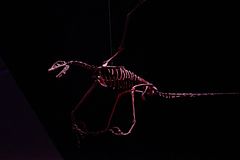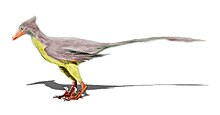Rahonavis
| Rahonavis | |
|---|---|

| |
| Reconstructed skeleton, Royal Ontario Museum | |
| Scientific classification | |
| Domain: | Eukaryota |
| Kingdom: | Animalia |
| Phylum: | Chordata |
| Clade: | Dinosauria |
| Clade: | Saurischia |
| Clade: | Theropoda |
| Clade: | Paraves |
| Genus: | †Rahonavis Forster et al., 1998b |
| Type species | |
| †Rahonavis ostromi | |
| Synonyms | |
| |
Rahonavis is a
The name Rahonavis means, approximately, "cloud menace bird", from Malagasy rahona (RA-hoo-na, "cloud" or "menace") + Latin avis "bird". The specific name, R. ostromi, was coined in honor of John Ostrom.
Discovery and species
The
The discoverers of Rahonavis initially named it Rahona but changed the name after discovering that the name
The lack of well-documented relatives of this species nonwithstanding, a single
A dentary has been found in association with the holotype, though it is seldom described.[7]
Classification

Rahonavis has historically been the subject of some uncertainty as to its proper taxonomic position – whether it is a member of the
Rahonavis could be a close relative to Archaeopteryx, as originally suggested by the describers, and thus a member of the clade Avialae, but while the pelvis shows adaptations to flight similar in function to those of Archaeopteryx, they seem to be independently derived.[8]
Beginning in the early 2000s, a consensus emerged among most theropod researchers that Rahonavis was more closely related to
This consensus has been challenged, however, by a few studies published since 2009 that have found many traditional "dromaeosaurids", including the unenlagiines, closer to Avialae than to dromaeosaurines. A large analysis published by Agnolín and Novas (2013) recovered Rahonavis as closer to Avialae than to Dromaeosauridae.[12] A cladistic analysis by Cau (2018) recovered Rahonavis as a probable relative of the long-tailed Early Cretaceous avialans Jeholornis and Jixiangornis.[13] The analysis of Hartman et al. (2019) "strongly rejected" the supposed avialan position of Rahonavis, finding its placement in Unenlagiinae better supported as it takes 10 less steps.[14] In 2020, Rahonavis and the South American Overoraptor were found to be sister taxa in a clade sister to the Avialae.[15] As of 2020, it is undecided among paleontologists whether the paravian Rahonavis is an unenlagiine, a dromaeosaurid or an avialan.[7]
Paleobiology

Although numerous artists' reconstructions of Rahonavis show it in flight, it is not clear that it could fly; there has even been some doubt that the forearm material, which includes the quill knobs, belongs with the rest of the skeleton. Some researchers have suggested that Rahonavis represents a
Chiappe maintained that Rahonavis could probably fly, noting that its ulna was large and robust compared to Archaeopteryx, and that this fact, coupled with the prominent quill knobs, suggest that Rahonavis had larger and more powerful wings than that earlier bird. Additionally, Rahonavis shoulder bones show evidence of ligament attachments allowing the independent mobility needed for flapping flight. Chiappe concluded that Rahonavis was capable of flight, though it would have been more "clumsy in the air than modern birds."
See also
References
- ^ Tudge, Colin (2009) The Bird:A Natural History of Who Birds Are, Where They Came From, and How They Live [1]
- ^ Holtz, Thomas R. Jr. (2008) Dinosaurs: The Most Complete, Up-to-Date Encyclopedia for Dinosaur Lovers of All Ages Supplementary Information
- ^ ISBN 978-0-471-24723-4.
- PMID 9506938.
- S2CID 220097569.
- .
- ^ S2CID 221507083.
- ^ S2CID 11576813.
- .
- hdl:2246/5823.
- PMID 17823350.
- ^ a b Agnolín, F.L.; Novas, F.E. (2013). "Avian ancestors. A review of the phylogenetic relationships of the theropods Unenlagiidae, Microraptoria, Anchiornis and Scansoriopterygidae". SpringerBriefs in Earth System Sciences. pp. 1–96.
- ^ Andrea Cau (2018). "The assembly of the avian body plan: a 160-million-year long process" (PDF). Bollettino della Società Paleontologica Italiana. 57 (1): 1–25. doi:10.4435/BSPI.2018.01.
- PMID 31333906.
- S2CID 218913199.
Further reading
- Forster, Catherine A.; O'Conner (2000). "The avifauna of the Upper Cretaceous Maevarano Formation, Madagascar". Journal of Vertebrate Paleontology. 3 (20): 41A–42A.
- Schweitzer, Mary H.; Watt, John A.; Avci, Recep; Forster, Catherine A.; Krause, David W.; Knapp, Loren; Rogers, Raymond R.; Beech, Iwona; Marshall, Mark (1999). "Keratin immunoreactivity in the Late Cretaceous bird Rahonavis ostromi". Journal of Vertebrate Paleontology. 19 (4): 712–722. JSTOR 4524040.
